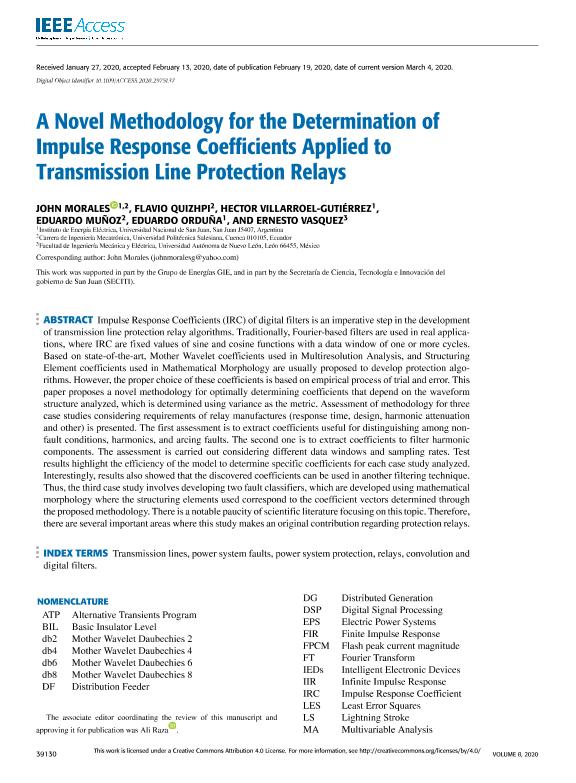Mostrar el registro sencillo del ítem
dc.contributor.author
Morales Garcia, John Armando

dc.contributor.author
Quizhpi, Flavio
dc.contributor.author
Villarroel Gutiérrez, Héctor Alejandro

dc.contributor.author
Munoz, Eduardo
dc.contributor.author
Orduna, Eduardo
dc.contributor.author
Vasquez, Ernesto
dc.date.available
2021-10-14T15:01:41Z
dc.date.issued
2020-02
dc.identifier.citation
Morales Garcia, John Armando; Quizhpi, Flavio; Villarroel Gutiérrez, Héctor Alejandro; Munoz, Eduardo; Orduna, Eduardo; et al.; A Novel Methodology for the Determination of Impulse Response Coefficients Applied to Transmission Line Protection Relays; IEEE; IEEE ACCESS; 8; 2-2020; 39130-39147
dc.identifier.issn
2169-3536
dc.identifier.uri
http://hdl.handle.net/11336/143580
dc.description.abstract
Impulse Response Coefficients (IRC) of digital filters is an imperative step in the development of transmission line protection relay algorithms. Traditionally, Fourier-based filters are used in real applications, where IRC are fixed values of sine and cosine functions with a data window of one or more cycles. Based on state-of-the-art, Mother Wavelet coefficients used in Multiresolution Analysis, and Structuring Element coefficients used in Mathematical Morphology are usually proposed to develop protection algorithms. However, the proper choice of these coefficients is based on empirical process of trial and error. This paper proposes a novel methodology for optimally determining coefficients that depend on the waveform structure analyzed, which is determined using variance as the metric. Assessment of methodology for three case studies considering requirements of relay manufactures (response time, design, harmonic attenuation and other) is presented. The first assessment is to extract coefficients useful for distinguishing among non-fault conditions, harmonics, and arcing faults. The second one is to extract coefficients to filter harmonic components. The assessment is carried out considering different data windows and sampling rates. Test results highlight the efficiency of the model to determine specific coefficients for each case study analyzed. Interestingly, results also showed that the discovered coefficients can be used in another filtering technique. Thus, the third case study involves developing two fault classifiers, which are developed using mathematical morphology where the structuring elements used correspond to the coefficient vectors determined through the proposed methodology. There is a notable paucity of scientific literature focusing on this topic. Therefore, there are several important areas where this study makes an original contribution regarding protection relays.
dc.format
application/pdf
dc.language.iso
eng
dc.publisher
IEEE
dc.rights
info:eu-repo/semantics/openAccess
dc.rights.uri
https://creativecommons.org/licenses/by-nc-sa/2.5/ar/
dc.subject
Finite impulse response filters
dc.subject
IIR filters
dc.subject
Relays
dc.subject
Multiresolution analysis
dc.subject
Power harmonic filters
dc.subject
Transient analysis
dc.subject.classification
Ingeniería Eléctrica y Electrónica

dc.subject.classification
Ingeniería Eléctrica, Ingeniería Electrónica e Ingeniería de la Información

dc.subject.classification
INGENIERÍAS Y TECNOLOGÍAS

dc.title
A Novel Methodology for the Determination of Impulse Response Coefficients Applied to Transmission Line Protection Relays
dc.type
info:eu-repo/semantics/article
dc.type
info:ar-repo/semantics/artículo
dc.type
info:eu-repo/semantics/publishedVersion
dc.date.updated
2021-09-07T13:55:56Z
dc.journal.volume
8
dc.journal.pagination
39130-39147
dc.journal.pais
Estados Unidos

dc.description.fil
Fil: Morales Garcia, John Armando. Consejo Nacional de Investigaciones Científicas y Técnicas. Centro Científico Tecnológico Conicet - San Juan. Instituto de Energía Eléctrica. Universidad Nacional de San Juan. Facultad de Ingeniería. Instituto de Energía Eléctrica; Argentina
dc.description.fil
Fil: Quizhpi, Flavio. Universidad de Cuenca.; Ecuador
dc.description.fil
Fil: Villarroel Gutiérrez, Héctor Alejandro. Consejo Nacional de Investigaciones Científicas y Técnicas. Centro Científico Tecnológico Conicet - San Juan. Instituto de Energía Eléctrica. Universidad Nacional de San Juan. Facultad de Ingeniería. Instituto de Energía Eléctrica; Argentina
dc.description.fil
Fil: Munoz, Eduardo. Universidad de Cuenca.; Ecuador
dc.description.fil
Fil: Orduna, Eduardo. Consejo Nacional de Investigaciones Científicas y Técnicas. Centro Científico Tecnológico Conicet - San Juan. Instituto de Energía Eléctrica. Universidad Nacional de San Juan. Facultad de Ingeniería. Instituto de Energía Eléctrica; Argentina
dc.description.fil
Fil: Vasquez, Ernesto. Universidad Autonoma de Nuevo Leon.; México
dc.journal.title
IEEE ACCESS
dc.relation.alternativeid
info:eu-repo/semantics/altIdentifier/url/https://ieeexplore.ieee.org/document/9003215/
dc.relation.alternativeid
info:eu-repo/semantics/altIdentifier/doi/http://dx.doi.org/10.1109/ACCESS.2020.2975137
Archivos asociados
